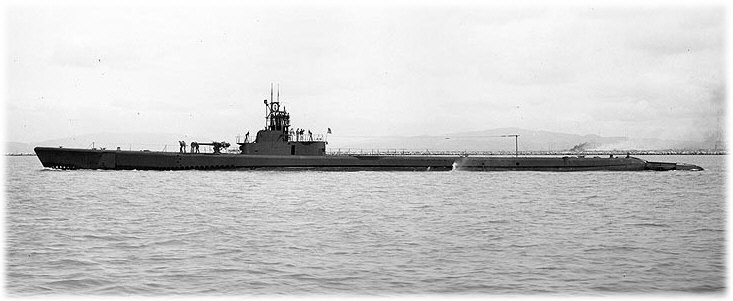USS
FLIER (SS-250)

USS FLIER (SS-250) departed Fremantle on August 04, 1944 for her 2nd
War Patrol enroute to the area off SIAGON, FRENCH INDO-China.
After
refueling at EXMOUTH GULF, FLIER departed early the next morning. She made passage through LOMBOCK STRAIT after the crew made
repairs to one of the engines that had blown.
On
Sunday, August 13th FLIER started up BALABAC STRAIT instead of
going through MINDORE STRAIT because they had received a dispatch
informing them of a Japanese Convoy going down the western side of PALAWAN
ISLAND.
Captain
CROWLEY had come to the bridge and at 2130 he called Battle Stations.
So now there were 4 Officers, 4 Lookouts and Captain Crowley on the
bridge.
At
2200 there was a very loud explosion.
The bridge was showered with oil, water and a lot of debris.
A gush of air came up from the Conning Tower carrying LT JAMES
LIDDELL (XO) to the bridge. Several
men scrambled up the ladder to the bridge.
The
FLIER was still making 15 knots and sank within a few minutes. It was later determined that FLIER had hit a mine.
Fifteen
survivors all gathered in the water in a group which included Captain
CROWLEY. The Navigation
Officer stated that land was on three sides of them at a distance of 14
miles and more but it was dark now with an overcast.
They could see some mountains in the distance when the lightning
would strike but lost all sense of direction without the lightning.
After
several hours of swimming, the tide and waves took their toll.
CHARLES D. POPE, GMC; GERALD F. MADEO, F2 and EDGAR W. HUDSON, MoMMC
were swept away and lost. A little later, LTjg W.L. REYNOLDS and Ens. P.S. MAYER, who
were badly injured, were not able to swim on and the Sea claimed their
lives. After being separated
from the group, LT PAUL KNAPP disappeared.
The
group agreed that the policy would be “Every Man for Himself”. Later LT JOHN E. CASEY, who had been blinded by oil, refused
help from ALVIN JACOBSON and soon disappeared.
At 0300 on August 14th the moon rose, the rain stopped and this raised the spirits of the group and made the going a little easier. They could not see any land until about 0500 when the sun rose. At this time they picked out the closest island and all agreed that each person would swim at their own pace, JAMES DELLO RUSSO, QM3 swam ahead and was the first to reach the island.
A
Japanese airplane flew over them at 1300 but did not see them in the
water. JACOBSON, GEORGE
HOWELL, CRT (AA) and EARL R. BUMGART, MoMM3 thought they saw a native
boat, it turned out to be a floating palm tree.
They caught onto it, which gave them some relief.
They spotted Captain CROWLEY and waved to him, he was just about
ready to give up but swam to them and the tree.
At
1530 they reached land after 17 hours of swimming.
JAMES DELLO RUSSO was waiting for them as they reached the beach.
As he walked to the end of the island he found DONALD P. TREMAINE,
FRC2. An hour later they
found WESLEY MILLER, MoMM3 who had reached the island in the dark and
spent the night there.
In
all, eight men of FLIER had survived the explosion, sinking and the sea
and they were; CDR JOHN D. CROWLEY (CO), LT JAMES W. LIDDEll (XO), Ens. ALVIN
E. JACOBSON, ARTHUR GEORGE HOWELL, CRT (AA), DONALD P. TREMAINE, FRc2,
JAMES DELLO RUSSO, QM3, EARL R. BUMGART, MoMM3 and WESLEY B. MILLER,
MoMM3.
They
survived for 5 more days living on the rain water collected in 20 large
sea shells. A raft which
could hold two people was constructed from bamboo found on the beach and
lashed together with vines found in the trees.
Captain CROWLEY made two paddles from the bamboo and they found two
long sticks. As a lot of the
water was shallow in places around the islands they would use the sticks
to propel the raft through the shallow water.
After
reaching several small islands they finally reached the fourth island and
met some friendly natives who gave them water, rice and some dried fish
then led them to a Coast Watchers Unit on PALAWAN.
Later it was discovered these were the same Coast Watchers that USS
REDFIN (SS-272) had landed. The
US Army Coast Watchers made contact with REFDFIN and arrangements were
made for their evacuation.
On
the night of August 30th the FLIER survivors made their way
offshore in native boats (Kumpits) to REDFIN and arrived onboard at 0103 on the morning of August 31, 1944.
The
survivors were grateful for the luck and stamina that kept them going, but
they would never forget their shipmates who were unable to ‘make it’.
This
material is based on a book written by;
Alvin
E. Jacobson
Survivor’s
Story Submarine USS FLIER
Lost
August 13, 1944
Published
August 1997
Revised
December 2002